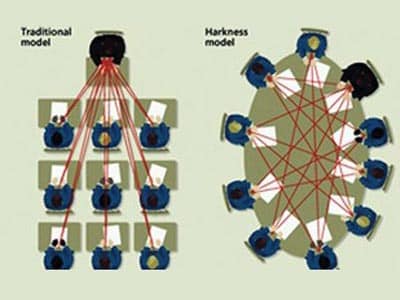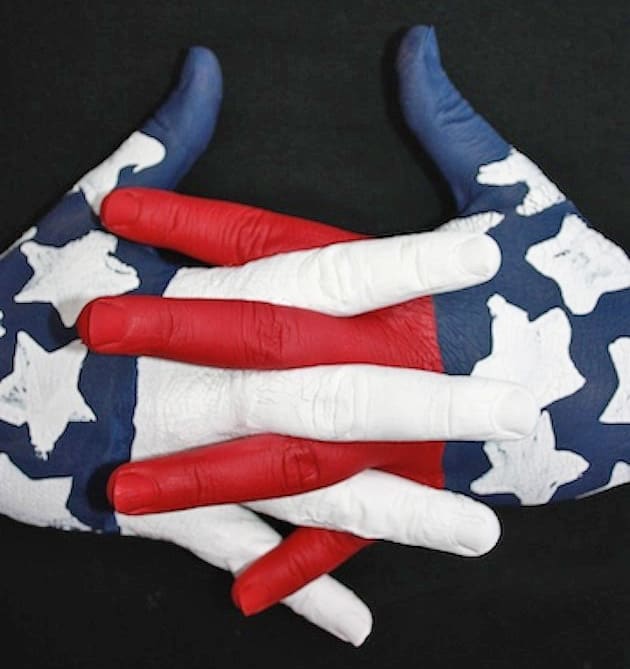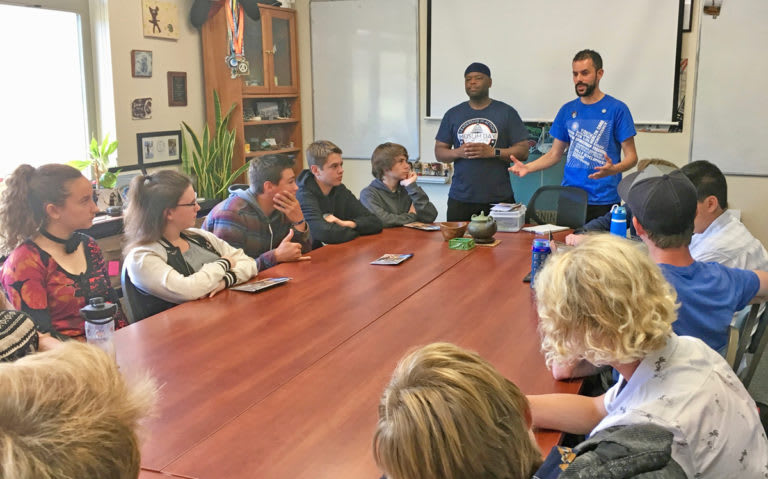“Once we grow accustomed to the Socratic method of learning, we wonder, how have we drifted so far from the circle? What ever made us think that rows upon rows of desks would be the way to engage and connect?”
Socratic Instruction is the oldest, most powerful teaching method in the world for fostering critical thinking students. Socratic instruction focuses on giving student questions (not answers), along with their own voices by cultivating independent thinking skills. In this context, Socratic instruction provides students with the tools to formulate answers to complex questions.
This is also why socratic instruction is so much more powerful than teaching methods that rely on rote memorization of dates, facts, names and other predetermined parcels of basic information. Instead, Socratic instruction prepares a student’s mind to probe the depths of a topic or subject, which helps him or her learn to focus on the elements of reasoning.
These elements allow real “education” to occur…. in which learners take control of every dimension of scholarly inquiry, instead of simply regurgitating a pre-manufactured answer to an oversimplified question that often fails to mirror the complexities and commonalities of life experiences outside the classroom environment.
Socratic Circle Discussion
If you think about it critically, Socratic instruction is also how human beings naturally process important experiences and meaningful interactions. In the “real world,” how many times do we choose to sit in orderly rows facing one direction to hold a discussion? Generally never, which is why classical classroom discussion protocol does not adequately equip students to become actively engaged social citizens. However, a Socratic circle discussion does.
We participate in a socratic circle discussion many times in our lives without even necessarily thinking about it. When we sit with our family and/or friends to share a meal, are we all sitting facing the same direction? No. Instead, we all sit “around” the table. Even if someone sits at the head of a rectangular table, he or she is not addressing the others sitting around that table like a teacher does when that teacher lectures to a classroom of (forward facing) students.
Another natural Socratic circle discussion is a campfire “gratitude” circle. Around the campfire, a group leader speaks in deference, thanking someone for some small action. Then, looking left, the next person speaks as the circle proceeded in gratitude, one after another.
No one thinks to sit in rows or face one direction on a campfire circle night. Nor does anyone decide to sit in a circle for that matter. There is the beauty of archetypes like the circle: Leadership expressed through universals and natural axioms, through generations and, in groups, on trips, around fires and treasures, the Socratic circle discussion organically becomes the host.
Exeter Harkness Table Method

A graphic representation of the traditional model of teaching and the exter-harkness table method of education
Human beings have sat together around fires since before the beginning of written record. In this sense, the Socratic circle discussion enjoys prehistoric roots. It also naturally it finds its way into great classrooms led by great teachers. In the modern world, “the circle way” is known as the Exeter-Harkness Table Method.
The Exeter-Harkness table method was originally developed in 1930 by Edward Harkness, a trustee of Phillips Exeter Academy in Exeter, New Hampshire. Harkness used a wide oval table as the centerpiece of a classroom that employs a Socratic or circle methodology. The Exeter-Harkness table method has successfully been employed at great schools, including The Grauer School, for generations now.
The Exeter-Harkness table method of teaching allows students to sit with their classmates and teachers around the table and discuss any and all subjects. It also allows them to process any issues, from mathematics to history, in detail and depth. As a result, in a way transcending what can be done in rows, individual and whole group opinions and consensuses are formed, raised, deepened, and clarified —as well as facing challenge or rejection, both courageously and openly.
Harkness Method of Teaching
Class size is critical to ensure success when using the Harkness method of teaching. For millennia, great teachers have engaged with approximately 12 students as an ideal number for a Socratic circle discussion.
The great teacher Christina Baldwin, founder of Peer Spirit, transformational circle leader, and bestselling author of “StoryCatchers,” was once asked by Dr. Grauer what she felt was the optimal class size. “I think 12,” she answered. In a 2006 interview with NPR before his death in 2007, Kurt Vonnegut was asked: “If you were to build or envision a country that you could consider yourself to be a proud citizen of, what would be three of its basic attributes”? Vonnegut responded: “Schools with classes of 12 or smaller.”
Likewise, the Harkness method of teaching is typically designed for 12, with a maximum of 14 possible student seats. This is why most of The Grauer School’s tables are set up for groups of this size. Larger conversations can be had, but they are not authentically representative of the Harkness method of teaching. Therefore, they tend to lack the intimacy and inclusion of true Socratic circles.
Socratic Circles in the Classroom
In a small school environment, where the teacher’s main responsibility is to support each student in the development of clear thinking, Socratic circles form in all humanities classes. Exeter actually has Harkness tables in math and science classes as well, but several students we interviewed while visiting Phillips Exeter Academy all noted that they are not used as much in those forums, and that they are primarily used in the humanities classrooms.
This is why Socratic circles are predominantly featured in our humanities-based subjects in schools like The Grauer School. Within Socratic circles, students are supported, acknowledged, and listened to at eye level. Socratic circles help students gain confidence and critical thinking skills while increasing interpersonal engagement. Meanwhile, the group develops a sense of connection and focus. Around the Harkness, students carve out their unique voices. This is the true Socratic method of teaching in action, and it remains perhaps the ultimate scholarly practice every classroom of teachers and learners can strive for.
The Socratic Method of Teaching in Action

What does the Socratic method of teaching look like in action? Imagine being an English student and walking into the classroom. Last night, you read a section of Homer’s epic poem, “The Odyssey.” An impassioned classmates claims, “Odysseus is annoying! He thinks he’s so heroic, but it costs some of his men their lives!”
You and your classmates are trying to weigh that comment. Someone jumps in and says, “I like him, he’s commanding. He’s a leader! Check out what he says on page 213…”
The Socratic method of teaching allows you to voice your educated opinion that you don’t agree with that assessment. Instead, you point out his betrayals. Students’ ideas fly around the table, caught and released.
Someone weighs in with Penelope’s viewpoint from back in Ithaca, and someone else expresses the voice of their son Telemachus having to defend her while Odysseus travels in far off lands. No one is left out of this discussion.
In this way, the Socratic method of teaching weaves a colorful tapestry out of a seemingly single thread leaving its traces all across the table. Everyone speaks his or her mind. Students learn to interact directly, to pass each idea around the circle rather than deflecting every comment off the teacher, as is the case in the typical rowed and columned classroom.
In the Socratic method of teaching, not every comment goes straight back to the teacher for his or her approval or judgment…. and this is what makes it truly revolutionary and engaging. Instead, ideas keep moving around and after a while, many ideas seem beyond right or wrong. In a safe and connected environment, the Harkness discussion method is authentic, exciting and inclusive. Everyone is an equal, and everyone is drawn in!
Harkness Discussion Method
The Harkness discussion method is not for novice teachers. But master teachers can reclaim the art of Socratic teaching and great conversation around the table. As Dr. Grauer recounts:
“I remember my classroom years ago, starting out as a public school teacher…. The students walking in, the chairs scattered about, the students taking them with no thought of guidance, the uneven rows that formed. Years later, I wondered why I had not said something, not told the students that I felt something was wrong in this room, not acted on my vague sense of disconnection and artificial hierarchy. It took many years, but I speak now. Around the table, at any great school, our vague senses as Socratic teachers have become clear intuitions that are somehow truer than anything we can prove. Archetypes.”
The Harkness discussion method allows every teacher to become a host. Every classroom has a center, and the task of the teacher using the Harkness discussion method is to “hold” that center. The teacher serves the role of guardian or “midwife,” as Socrates called it. The Harkness discussion method also allows roles to naturally shift. Sometimes the teacher is clearly the teacher…. and sometimes someone else becomes the teacher, and the teacher actually becomes the student. In this way, the Harkness discussion method allows teachers and students to share leadership by passing it around like a ball.
Harkness Table Discussion
The host is not responsible for the progress or happiness of those in a Harkness table discussion, or even for knowing all the answers. Instead, the host-teacher is responsible only for holding the open space of the circle so that everyone has the opportunity to be a part, so that every voice is heard.
The Harkness table discussion requires patience and encouragement, and it does not deem answers as right or wrong. Instead, “I arrived at a different conclusion than that, so how did you arrive at your answer?” the great Socratic teacher might ask. The host cares about the clarity of every thought expressed, and he or she probes for this, never judging. Eventually we all probe. A Harkness table discussion allows us to sense a leader in every seat, and to know that we are becoming successful.
Harkness tables are expensive, with custom made models costing upwards of seven thousand dollars a piece. But the value of the Harkness table discussion and thus, the Socratic method of learning is priceless, as generations of learners from Ancient Greece to modern day small schools around the world readily attest.
Socratic Method of Learning
Teaching is an ancient art. Once we grow accustomed to the Socratic method of learning, we wonder, how have we drifted so far from the circle? What ever made us think that rows upon rows of desks would be the way to engage and connect? When did the teacher become the manager, boss, captain…. or even the drill sergeant?
These are all ways of forcing compliance, but rarely of refining thought or developing ideas and creativity. Around the Harkness, or wherever there is a center, a fire ring, or a treasure, we rediscover the powerful, elegant, origin role of the teacher.
That night on the shores of Catalina, the Socratic method of learning was on full display as one student became the fire tender. His name was Ryan, a 10th grader. We remember this vividly because back home Ryan’s identity always seemed in turmoil, but here it was simple. We gathered around the fire. Above us, the dry trails ran inland. Red toyon berries jutting out over the sand. Mackerel skies —tomorrow, clouds were moving in but we’d be gone. No one decided that this would be a circle, and everyone was heard in an infusion of gratitude as the circle did its work.
We have hosted gratitude circles like this in almost every expedition we have run for approaching three decades, and we have found no greater way to define success at our school than the kind of gratitude and acceptance we have come to expect from around the circle. Increasingly, we have brought the circle back home and with it, our dedication to the Socratic method of learning, to all of our humanities classes.
If you would like to discuss the Socratic method of learning in more depth, or to become a Small Schools Coalition member totally free-of-charge, we welcome you to contact us.


Recent Comments